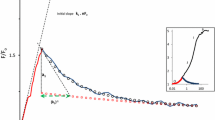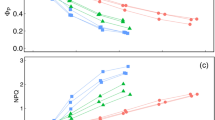Abstract
Photoinhibition of photosynthesis in willow (Salix sp.) leaves was investigated by measuring the ratio of variable (Fv) to maximal (FM) chlorophyll fluorescence. The use of this parameter was justified as it showed similar kinetics of recovery from photoinhibition as did the light-limited rate of gross photosynthesis. When leaves of different status were exposed to different environmental conditions for 1 h, the large variation in photoinhibition subsequently observed was not correlated with the incident photosynthetic photon flux density. However, it was positively correlated with the fraction of closed reaction centres of photosystem (PS) II, and negatively correlated with the magnitude of the high-energy fluorescence quenching, both of which were measured during the treatment. The best correlation was obtained when the two parameters were taken together in a multiple regression model. Young high-light-acclimated leaves were the most resistant to photoinhibition at a given fraction of closed PSII centres, which was explained by these having the most prominent high-energy quenching. Leaves illuminated in the presence of dithiothreitol and the uncoupler nigericin were found at the other end of the correlation. However, the markedly lowered high-energy quenching induced by dithiothreitol was not fully matched by the expected increase in photoinhibition. The fraction of closed PSII centres provided a relative not an absolute measure of excessive excitation, since the correlation model varied depending on the length of the treatment. In a separate experiment the response to fluctuating light under otherwise constant conditions was studied. It was found that under these more restricted conditions photoinhibition could be predicted from the integrated light dose.
Similar content being viewed by others
Abbreviations
- DTT:
-
dithiothreitol
- F0 :
-
minimum fluorescence
- Fv :
-
variable fluorescence
- FM :
-
maximum fluorescence
- PPFD:
-
photosynthetic photon flux density
- PS:
-
photosystem
- QA:
-
primary stable electron acceptor of PSII
References
Anderson, J.M., Chow, W.S., Goodchild, D.J. (1988) Thylakoid membrane organisation in sun/shade acclimation. Aust. J. Plant Physiol. 15, 11–26
Bilger, W., Björkman, O., Thayer, S.S. (1989) Light-induced spectral absorbance changes in relation to photosynthesis and the epoxidation state of xanthophyll cycle components in cotton leaves. Plant Physiol. 91, 542–551
Björkman, O., Powles, S.B. (1984) Inhibition of photosynthetic reactions under water stress: interaction with light level. Planta 161, 490–504
Demmig, B., Björkman, O. (1987) Comparison of the effect of excessive light on chlorophyll fluorescence (77K) and photon yield of O2 evolution in leaves of higher plants. Planta 171, 171–184
Demmig, B., Winter, K., Krüger, A., Czygan, F.-C. (1987) Photoinhibition and zeaxanthin formation in intact leaves. A possible role of the zanthophyll cycle in the dissipation of excess light energy. Plant Physiol. 84, 218–224
Horton, P., Hague, A. (1988) Studies on the induction of chlorophyll fluorescence in isolated barley protoplasts. IV. Resolution of non-photochemical quenching. Biochim. Biophys. Acta 932, 107–115
Krause, G.H., Behrend U. (1986) ΔpH-dependent chlorophyll fluorescence quenching indicating a mechanism of protection against photoinhibition of chloroplasts. FEBS Lett. 200, 298–302
Krause, G.H., Vernotte, C., Briantais, J.-M. (1982) Photoinduced quenching of chlorophyll fluorescence in intact chloroplasts and algae. Resolution into two components. Biochim. Biophys. Acta 679, 116–124
Leverenz, J.W., Falk, S., Pilström, C.-M., Samuelsson, G. (1990) The effects of photo-inhibition on the photosynthetic lightresponse curve of green plant cells (Chlamydomonas reinhardtii). Planta 182, 161–168
Ludlow, M.M., Björkman, O. (1984) Paraheliotropic leaf movement in Siratro as a protective mechanism against drought-induced damage to primary photosynthetic reactions: damage by excessive light and heat. Planta 161, 505–518
Markgraf, T., Berry, J. (1990) Measurement of photochemical and non-photochemical quenching: correction for turnover of PS2 during steady-state photosynthesis. In: Current research in photosynthesis, vol. IV, pp. 279–282, Baltscheffsky, M., ed. Kluwer Academic Publishers, Dordrecht
Ögren, E. (1988a) Suboptimal nitrogen status sensitizes the photosynthetic apparatus in willow leaves to long term but not short term water stress. Photosynth. Res. 18, 263–275
Ögren, E. (1988b) Photoinhibition of photosynthesis in willow leaves under field conditions. Planta 175, 229–236
Ögren, E., Baker, N.B. (1985) Evaluation of a technique for the measurement of chlorophyll fluorescence from leaves exposed to continuous white light. Plant Cell Environ. 8, 539–547
Ögren, E., Sjöström, M. (1990) Estimation of the effect of photoinhibition on the carbon gain in leaves of a willow canopy. Planta 181, 560–567
Ohad, I., Kyle, D.J., Arntzen, C.J. (1984) Membrane protein damage and repair: removal and replacement of inactivated 32 kilodalton polypeptides in chloroplast membranes. J. Cell Biol. 99, 481–485
Öquist, G., Ögren, E. (1985) Effects of winter stress on photosynthetic electron transport and energy distribution between the two photosystems of pine as assayed by chlorophyll fluorescence kinetics. Photosynth. Res. 7, 19–30
Osmond, C.B. (1983) Interactions between irradiance, nitrogen nutrition, and water stress in the sun-shade responses of Solanum dulcamara. Oecologia 57, 316–321
Powles, S.B. (1984) Photoinhibition of photosynthesis induced by visible light. Annu. Rev. Plant Physiol. 35, 15–44
Powles, S.B., Critchley, C. (1980) Effect of light intensity during growth on photoinhibition of intact attached bean leaflets. Plant Physiol. 65, 1181–1187
Schreiber, U., Schliwa, U., Bilger, W. (1986) Continuous recording of photochemical and non-photochemical chlorophyll fluorescence quenching with a new type of modulation fluorometer. Photosynth. Res. 10, 51–62
Somersalo, S., Krause, G.H. (1990) Effects of freezing and subsequent light stress on photosynthesis of spinach leaves. Plant Physiol. Biochem. 28, 467–475
Styring, S., Virgin, L, Jegerschöld, C., Andersson, B. (1989) The effects of photoinhibition on the structure and function of photosystem II. Physiol. Plant. 76, A27
Von Caemmerer S., Farquhar, G.D. (1981) Some relationships between the biochemistry of photosynthesis and the biochemistry of leaves. Planta 153, 376–387
Weis, E., Berry, J. (1987) Quantum efficiency of photosystem II in relation to “energy” -dependent quenching of chlorophyll fluorescence. Biochim. Biophys. Acta 894, 198–208
Author information
Authors and Affiliations
Additional information
This study was supported by the Swedish Natural Science Research Council.
Rights and permissions
About this article
Cite this article
Ögren, E. Prediction of photoinhibition of photosynthesis from measurements of fluorescence quenching components. Planta 184, 538–544 (1991). https://doi.org/10.1007/BF00197904
Received:
Accepted:
Issue Date:
DOI: https://doi.org/10.1007/BF00197904




